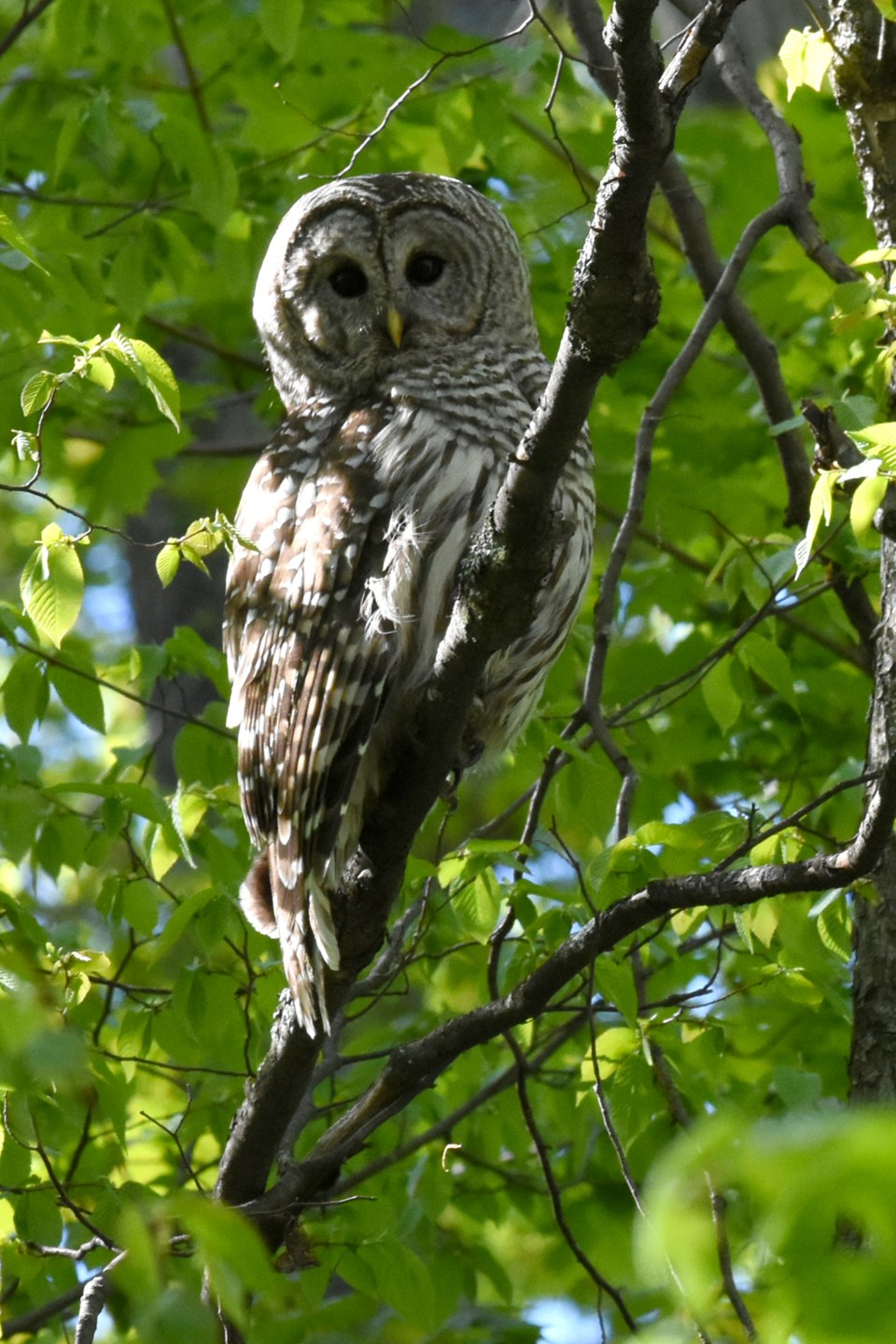The sound coming from our woodlot was eerie, not just because of its sound but that it was the middle of the afternoon. Eerie wails are a night-time thing, when raccoons, fisher and other things that go bump in the night are out and about. It was a single note, drawn out with a downward slide to it, repeated once every two minutes.
The brilliant sunshine made it easy to see, which caused my bravery level to be better than at, say, 1 a.m. and so I ventured into the deep woods, camera held at the ready. The single mournful call continued, still at a minute or two between calls. What in the world could it be?
About halfway up the rather steep slope of the hardwood stand, I paused to look about. Silence. Then a dark shadow moved, travelling fast, well defined by the overhead sun. The moving shadow abruptly stopped, and with a bit of triangulation involving the angle of the sun and the height of the shadow above the ground, I deduced the mystery thing should be right about ... there!
And there it was! Large brown eyes staring at me, its body posture indicating it was less than pleased to see me. And now another call, different from the one that got me here in the first place, a loud direct "whooooooooo". It was a barred owl, and a grumpy one at that!
As I watched the bird through the camera lens the branch upon which it perched moved up and down a little, due to the impact of the landing. The owl bobbed its head in the opposite direction of the bouncing branch, thus keeping its piercing gaze rock steady while the body went up and down. Barred owls have brown eyes (rather than the typical yellow noted on other species) and the intent attention it was displaying really struck deep within me.
Just then a second owl called, off in the distance a bit, again the single note call. "My" owl snapped its attention to this, flew to another branch landing just long enough to reposition its direction, then was gone, a silent shadow through the woods.
Way cool!
Wondering if perhaps they had a nest nearby, the next 20 minutes or so was spent perusing the high canopy of the maple and beech trees, looking for a stick nest lodged in a secretive notch. No luck. However, as these owls have been calling quite regularly of late (their normal "who-cooks-for-you-alllll" call) there is the assumption that young owlets may be seen anytime soon.
Not sure what's up with the local barred owl population, but for the last couple years it seems that "everybody" is seeing this species. Once upon a time to see a barred owl was about on par with discovering a great horned or saw-whet ... possible but not a common occurrence. Nowadays barred owls are at bird feeders and woodlots all around us.
Wandering back down the steep slope, watching for trip hazards while at the same time keeping a view of the tree tops for a nest, another shadow flits out in the open. But this shadow is small, almost furtive, close to the ground. I pause by leaning on a large maple, hoping that by stopping my movement I may better detect the movement of others.
Sure enough, a slightly-less-than-robin-sized bird lands on a wispy stem of a maple sapling. Camera is brought up and a few frames are shot. I know that it's a thrush, but which one? Veery? Wood? Grey-checked? The thrush family also includes robins and bluebirds, but they are not deep woods dwellers. A moment later the bird flies off, joined by another in the leafy understory of the forest.
Back home the computer is fired up and a few searches begin. First is to determine if barred owls make that single note call while near the nest, or in distress, or if just checking in with its mate? Oodles of video clips come up, each one a revealing segment of how incredibly varied these owls are with their vocalizations. But no single note call is recorded. Looks like more field work will be needed to discover what the locals are up to.
As for that thrush on a branch, the photos are processed and with a bit of enlargement a pale eye-ring is noted along with a light-coloured cheek patch. The back and tail are a uniform olive-brown which eliminates the wood thrush (reddish head) and the hermit thrush (reddish tail). Veerys have a uniform warm-brown head, back and tail, whereas this was definitely an olive-brown.
That left either grey-cheeked or Swainsons thrush. A check with the Peterson Field Guide to the Birds determined that the Swainson has the pale eye-ring, so an identification was confirmed. Could I have done that with just binoculars in the field? Not sure anymore. But I do like a good telephoto lens and a photo processing program.
And so, in the span of about 30 minutes, two interesting observations occurred right beside the house. All it took was some curiosity, a bit of effort, a whole ton of luck and suddenly the day was enriched significantly. As the saying goes, if you don't look, you won't know. So keep your eyes (and ears) open to find out more about your natural neighbourhood.
